Search results for: 'form'
-
 Römisches Gewicht in Form einer Schnecke
Römisches Gewicht in Form einer SchneckeAntikes Gewicht aus Blei, tierförmig. 14 Oboli, entsprechend 7,9g.
Price: on request Ancient coin forger's lead form - found in Nothamptonshire, UK
Ancient coin forger's lead form - found in Nothamptonshire, UKGefunden in Pitchley, UK, am 1. Januar 2008. Der Fund ist mit PAS Nummer dokumentiert und wissenschaftlich untersucht. Von außerordentlicher Seltenheit.
Price: on request Antike Münzform für Falschgeld - Fund aus Northamptonshire
Antike Münzform für Falschgeld - Fund aus NorthamptonshireGefunden in Pitchley, UK, am 1. Januar 2008. Der Fund ist mit PAS Nummer dokumentiert und wissenschaftlich untersucht. Von außerordentlicher Seltenheit.
Price: on request Roman sandal sole type fibula
Roman sandal sole type fibulaDie Form wird in der Literatur als Schuh- oder Sandalensohle bezeichnet. Der sehr dekorative Fibeltyp war extrem beliebt und im zweiten Jahrhundert weit verbreitet. Er stammt aus den nördlichen römischen Provinzen.
Price: on request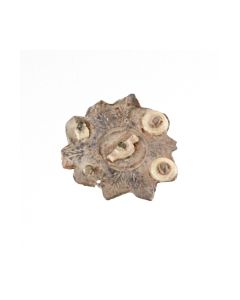 Elaborate Roman plate brooch
Elaborate Roman plate broochTen pointed star form with leaf pattern and decorative buttons. A product of Gaul or Britain dating to the 1st century.
Price: on request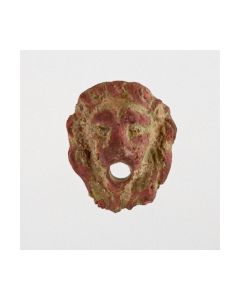 Roman bronze mount shaped as a lion's head
Roman bronze mount shaped as a lion's headFound in Dunham on Trent, Nottinghamshire, Great Britain on 8th of November 2013
€150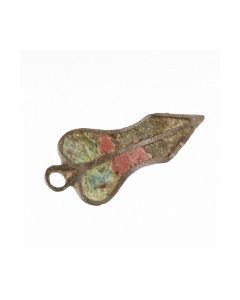 Roman brooch in dagger shape
Roman brooch in dagger shapeInteresting variant of the more common sandal brooch. The colourful enameled brooch has been made in the northern Roman provinces. 2nd cent. AD.
Price: on request Bird shaped Roman brooch
Bird shaped Roman broochProduct of Northern Europe dating to the second century AD. Brooch worked as a flat relief, once with multi-coloured inlays.
Price: on request Roman swastika brooch
Roman swastika broochThe swastika shape was known to the Romans as crux gammata. This brooch type of the later Imperial period was used in large parts of the Roman Empire.
Price: on request Roman fibula in the shape of a rabbit
Roman fibula in the shape of a rabbitNice zoomorphic roman fibula made of bronze with enamel inlays depicting the young of the rabbit. Found near the Limes fortifications Pfoerring and Eining in Germany.
Price: on request Roman brooch of a swimming bird
Roman brooch of a swimming birdStylized bird shaped brooch made of bronze. Northern European brooch type from the Roman Pricipate.
Price: on request Keltisch-römische Ringfibel
Keltisch-römische Ringfibel1. Jh. v.Chr. bis 1. Jh. n.Chr., Ende der keltischen Epoche, Beginn der römischen. Hervorragender Zustand, schön patiniert, mit Nadel. Rautenförmiger Querschnitt.
Price: on request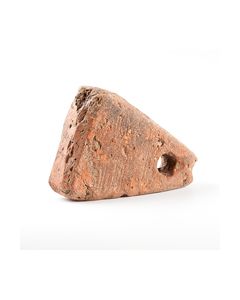 Roman clay loom weight
Roman clay loom weightMassives Gewicht aus Terrakotta mit Öse zur Aufhängung als Webgewicht, aus der römischen Kaiserzeit, Germanische Provinzen, 1. bis 2. Jh. n. Chr.
Price: on request Antike Bronzefibel mit P-förmigem Profil
Antike Bronzefibel mit P-förmigem ProfilFibelbogen schön verziert. Nadel intakt. 3. Jh. v. Chr. - 4. Jh. n. Chr. Latene-Zeit bis römische Zeit. Fund aus Region der Limeskastelle Pförring, Eining, Pfünz, Kösching und Weißenburg.
Price: on request Roman brooch of a swimming duck
Roman brooch of a swimming duckThree-dimensional bird shaped brooch with crescentic inlays of orange and blue enamel. Northern European type from the Roman Pricipate.
Price: on request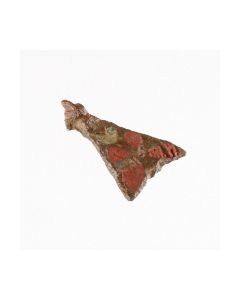 Roman cicada brooch
Roman cicada broochBrooch in the shape of an insect. Popular type in the northern Roman provinces during the 2nd century.
Price: on request Roman plate brooch with colourful enamel
Roman plate brooch with colourful enamelRare fibula type from Roman Britain. The fully intact multicoloured enamel makes this piece worthy of being a museum exhibit. 2nd cent. AD.
Price: on request Rare discus-shaped Celtic-Roman fibula
Rare discus-shaped Celtic-Roman fibulaAus der Entstehungszeit der plattenförmigen Fibeln, 1. Jh. n. Chr. Ästhetisch ansprechende Metallarbeit aus einer Fusion keltischer Handwerkstraditionen mit römischen Vorlieben.
Price: on request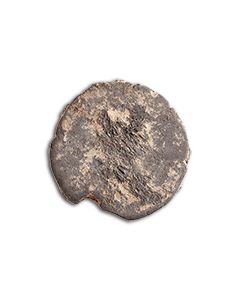 End piece for ancient terracotta forger's mould
End piece for ancient terracotta forger's mouldThe perfectly preserved mould was used to counterfeit coins with a FEL TEMP REPARATIO reverse and was used frequently. From time of Constantius II (337-361 AD) or slightly later.
Price: on request Gorgeous Roman Imperial fibula
Gorgeous Roman Imperial fibulaThe large bow is dominated by colourful enamel. It is a brooch type that developed during the 1st cent. AD in Central Europe.
Price: on request Gallo-Roman animal fibula
Gallo-Roman animal fibulaZoomorphe Fibel mit Wildtier als Motiv. Schmuckstück mit religiöser Symbolik, vergleichbar einem Kreuzanhänger bei heutigen Christen. Gefertigt im 1. bis 3. Jh. n. Chr. in Gallien.
Price: on request Ancient terracotta forger's mould
Ancient terracotta forger's mouldThe mould was used to counterfeit coins with a FEL TEMP REPARATIO reverse and was used frequently
Price: on request Roman fibula from the Richard Hattatt collection
Roman fibula from the Richard Hattatt collectionLozenge-shaped ancient roman fibula. The piece is published in the standard work "Iron Age and Roman Brooches". Found in Norfolk, England.
Price: on request Titus denarius from Wishanger hoard
Titus denarius from Wishanger hoardGreat dark patina. Found 2021 in East Hampshire, UK. The hoard is a very impressive proof of the fact that coins were in circulation for up to several centuries in the Roman era.
Price: on request Roman Colchester type brooch
Roman Colchester type broochRare variant of this brooch type, found in Great Britain and dating to the mid 1st century AD. The piece is published twice in the famous Hattatt reference books on ancient fibulae.
Price: on request Enameled disc brooch from Britain
Enameled disc brooch from BritainColourful enameled brooch from the Roman Imperial period. Published in two stardard works on ancient brooches by Richard Hattatt.
Price: on request Große Gruppe römischer Tonziegel, meist gestempelt
Große Gruppe römischer Tonziegel, meist gestempelt2012 aus dem Privatbesitz T. Bak erworben, an welchen in dritter Familiengeneration die Sammlung von Professor Josef Lambinet übergegangen ist. Nach Angaben und Dokumenten von Prof. Lambinet wurden die Objekte um 1920 in Mainz gefunden, unmittelbar an der römischen Wasserleitung Mainz-Zahlbach.
Price: on request

